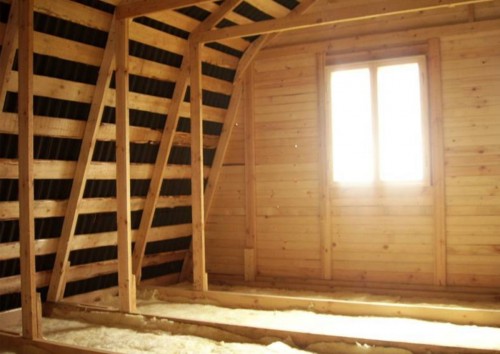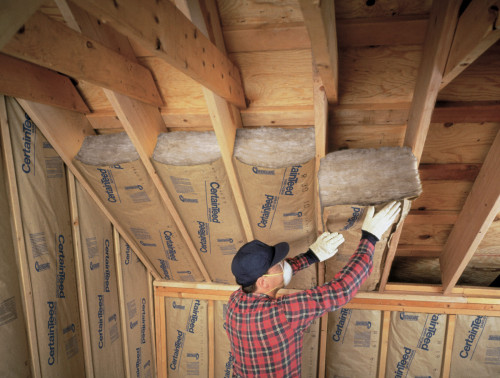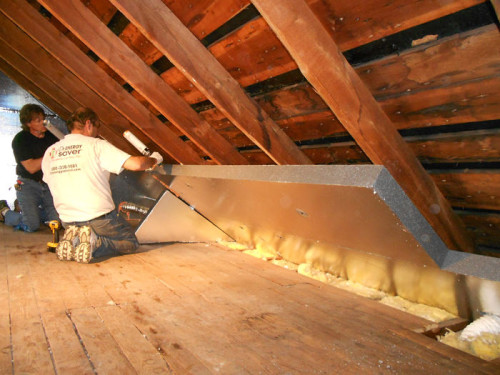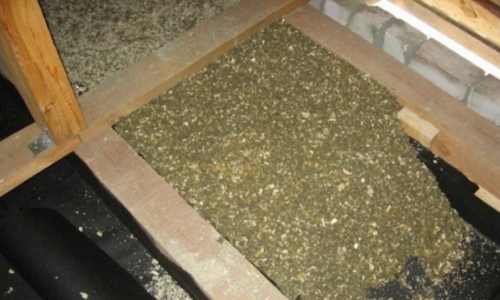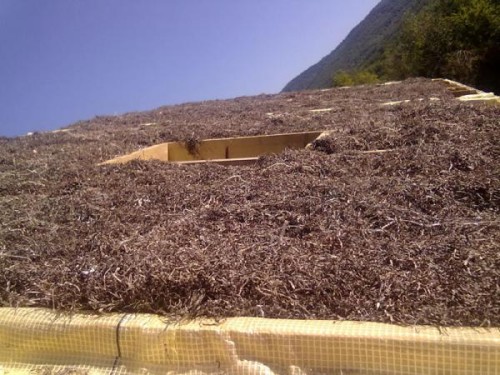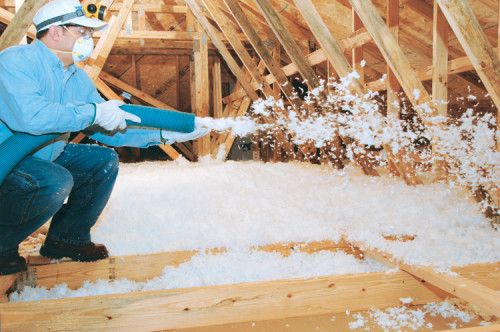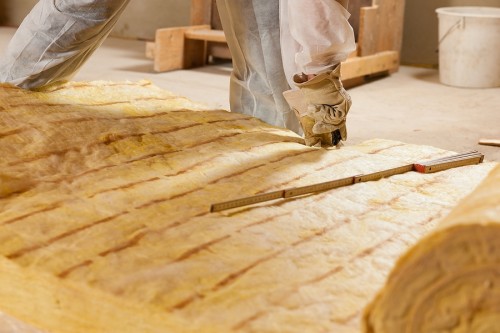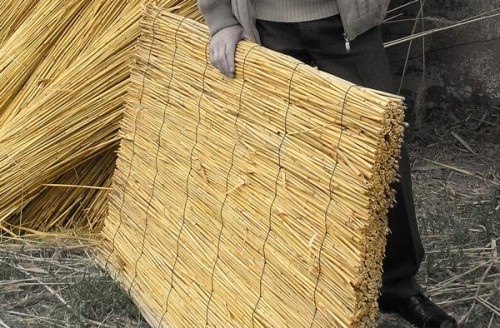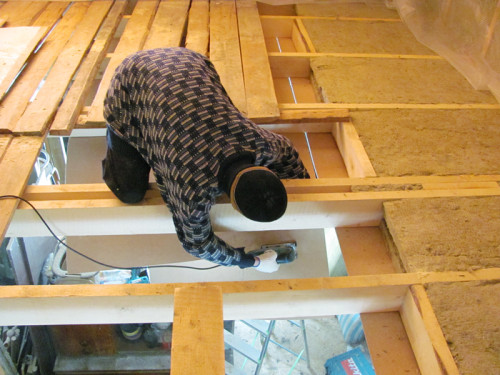
Cold attic: insulation instructions Construction

The insulation of the attic room will help to achieve a comfortable temperature inside the house, significantly reduce the cost of heating, as well as increase the useful area of \u200b\u200bthe building. The room after this procedure can be used as a residential area. In addition, the laying of the insulation will help solve another problem - the formation of condensate on the ceiling due to temperature difference. We will tell about all the characteristics of the insulation of the attic in this article.
Content
- Varieties of insulation
- Cold ceiling insulation: Preparatory work
- Warming overlapping of a cold attic Minvata
- Warming of a cold attic foam
- Warming of a cold attic sawdust
- How to insulate a cold attic with straw
- Hearth overlapping a cold attic Eco
- Warming of a cold attic in a private house fiberglass and clay
- How to insulate a cold attic reed
- Application of algae and linen heaters
- Ceiling insulation Cold attic
- Conclusion
Varieties of insulation
The technology of laying each insulating material has its own characteristics, but there are general requirements for this process. Works are performed in a specific sequence. It is initially provided by a cold attic vaporizolation, then the insulation is mounted, and at the final stage - the material protecting thermal insulation from the wind.
Insulation materials are divided into three groups:
- tile - mineral wool, polystyrene foam, foam, reed;
- rolled - flax, minvat, glass wool;
- bulk - clamzit, slag, eco-art, sawdust, straw.
Cold ceiling insulation: Preparatory work
- Before starting the insulation installation, it is necessary to hydroize and heat the roof.
- If there is a previous insulation, you need to check its condition. If certain parts of the material are subject to the process of rotting or mold, then they should be removed and carried out with antifungal agents.
- It is necessary to make sure that there are no cracks in the floors, frontones and the rafter system. If these defects are detected, they are eliminated by spitting or replacing damaged elements.
- You can get rid of the slots using a pacule impregnated with a lime solution. For this purpose also use sealant or construction foam.
- Wooden elements are processed by special means that protect them from fire.
You need to make sure the proper functioning of the ventilation system. In case of its malfunction on the surface of the ceiling, condensate will accumulate. If the roof is covered with a material that does not let air, it is necessary to provide ventilation products. Their size should be 0.001 from the area of \u200b\u200bthe ceiling plate. If tile or slate is used as roofing material, then the product is not necessary, since such a coating has gaps. But this refers to those houses, under the roofs of which there is no waterproofing layer.
Warming overlapping of a cold attic Minvata
Mineral wool is distinguished by low thermal conductivity, resistant to high temperature and chemicals. In addition, this material has sound insulation properties, so its use will solve two tasks at once. The features of laying mineral wool look like this:
- First of all, a vapor insulation layer is stacked on the overlap. It can be a special membrane, foil or polyethylene film. Vaporizolation lay the peaks, and the areas of the joints are treated with adhesive composition.
- Next, the coacter rolls are filling on top of the laid layer. Minvatu is placed between the elements of the rafter system.
- From the side of the eaves, the material is placed horizontally, setting it on the edge. This will help create a barrier that will prevent wind penetration.
- If the attic room is purged, an additional insulation is placed on top of mineral wool rolls, which has parroproping properties. For this purpose, you can choose the Izospan.
- On the Minvati, vaporizolation does not fit. When it is presented, the moisture will act in a layer of insulation, and this will inevitably entail the appearance of mold and the material will lose its operational qualities.
Warming of a cold attic foam
The use of this insulation will allow the monolithic heat insulating coating without joints. Polyfoam can be insulated at home with brick floors, metal or wood. Low thermal conductivity of the material allows you to get a thin layer of heat insulation, which makes it possible to save the useful area of \u200b\u200bthe room. This is especially true when using the attic as a residential area. Polyfoam does not miss moisture and thus protects the house from the formation of condensate.
The features of the process of insulation of foam look like:
- This insulation is laid on a flat surface. Therefore, before starting work, all the defects of the overlap must be eliminated.
- The prepared base initially fears vaporizolation.
- Next, the plates of the insulation are stacked according to chess order.
- The joints of the joints are filled with mounting foam.
- After it is frozen, the material is poured with a layer of cement-sandy solution with a thickness of 5 cm. Such a screed can be used as an attic floor.
Warming of a cold attic sawdust
This method is less popular due to the fact that the material is inferior to the operational qualities of minvati or foam. However, if you decide to insulate the attic by sawdust, you should follow these rules:
- First you need to eliminate the existing gaps. You can do it with clay or modern putty.
- A small amount of sand is poured on top. If cracks appear in clay, its small fractions will fill the slots.
- Further, the base should be sprinkled with a mixture of hawed lime and carbide. This composition will help to avoid the appearance of mice.
- After the preparation is completed, you can proceed to layers. They are poured with a layer of up to 20 cm. The sawmills belong to the combustible materials, the poet from above they need to be sprinkled with slag work.
- Particular attention should be paid to zones near hot objects, such as chimneys. Alternatively, the slag can be applied anti-epires that are processed by sawdust.
On this work on insulation completed. I don't need to lay on top of the sawdust. For the convenience of movement, you can put boards.
How to insulate a cold attic with straw
An alternative use of sawdust is a straw insulation:
- Initially, the foundation of the attic is covered with a layer of clay no more than 5 mm.
- Next stacked straw. The thickness depends on climatic conditions and can vary from 20 to 50 cm.
- When using this insulation, combating mice is also an urgent problem. To do this, use harated lime with the addition of carbide or another substance that can prevent the appearance of rodents.
- In order to prevent the heat of the heat-insulating material on top of the straw, clay layer in 2 cm is applied.
Hearth overlapping a cold attic Eco
Equata is a recycled waste paper. To minimize the combustibility of the material in its composition add mineral binding components. Eco-out fibers have the ability to absorb moisture, so when it does not need to be laid vaporizolation. But the film base experts are still recommended to seize.
This insulation is stacked by means of a blowing unit. The advantage of this method is the lack of need to prepare a working basis. As a result of the installation of the installation layer of the insulation, it turns out to be homogeneous without cracks. To make an eclaw with its task and ensured the necessary thermal insulation effect, its thickness should be 25 cm.
But during the work, the ability of the insulation to decrease in size after some time should be taken into account. For this reason, in the process of blowing, a layer is formed, which in thickness exceeds 15% the recommended norm. After 1-3 weeks, a protective crust will appear due to the upper fibers of the upper fibers. This process can be accelerated by insignificant insulation wetting after the end of the installation.
Warming of a cold attic in a private house fiberglass and clay
Glasswater is characterized by a significant number of positive performance. It is resistant to fire, exposure to moisture and rotting processes. The glass gamble is an unfavorable environment for habitat rodents and various microorganisms, so pests do not come in it. But at the same time, this material has a high level of toxicity.
A prerequisite for using this insulation is the use of a respirator, gloves and tight clothing, which is then burned after installation. The glass gamble is stacked with a layer of 15 to 25 cm. It has a property to lift, so after a certain period of time, the fiberglass will have to be replaced.
Another case of insulation is the use of clay. It is mainly used for concrete floors. At first, a layer of claymzite with a thickness of 20 cm is poured on the surface, which is poured on top of 5 cm cement mixture. This method will help not only insulate the room, but also get a full floor.
How to insulate a cold attic reed
The main advantage of the Kamysh is environmental safety. This is a relatively new material that is not inferior in thermal insulation qualities to other insulation. Released in plates. In the event of ignition, the reed is able to restrain the spread of fire. To reduce its flammable material treated with flame retardant.
Reeds suitable for wooden and concrete floors. Installation of vaporizolation in this case is not a prerequisite. So that it is convenient to move on insulated overlap, you can put the fibrillery plates on top.
Application of algae and linen heaters
Draps are made from Zostera - seaweed. This is a natural material with high thermal insulation qualities that is not subjected to rotting, as well as the effects of microorganisms and mice. This properties of the lady gives the iodine and sea salt. When contacting with fire, they do not light up, but only a little smashed. In this case, the toxic elements do not distinguish. Algae are not susceptible to moisture. Therefore, during their installation, you do not need to lay vaporizolation. Frames are mounted directly on the surface of the overlap layer to 20 cm.
Linen insulation are produced in the form of rolls. Made on the basis of natural raw materials, which makes the material absolutely eco-friendly. They are used in most cases for the insulation of the attic of wooden houses.
Mounting technology such insulation is quite simple. Preparatory work is limited to the elimination of gaps in the ceiling, they are smeared by clay. There is no need for vaporizolation. Then linen rolls are stacked. When installing, you need to monitor so that the slots remain.

Ceiling insulation Cold attic
This method is applied if access to an attic basis is difficult. It has a certain disadvantage, the height of the ceilings in the room will slightly decrease. Warming implies the same actions as during the heat insulation of the overlap, only in the reverse order. First, the vapor barrier film is stacked, then the insulation, which is covered with a steam insulating material from above. This is the difference between this method. In the heat insulation of the overlap on the insulation, the steaming layer is stacked.
Cold attic ceiling is insisted in the following order:
- The membrane is attached to its surface by means of sealing glue.
- Then the lamp is mounted from wooden plates with a step of 50 cm.
- The insulation is placed in the space between the frame elements.
- With glue, a steamproof membrane is fixed.
- On this work is completed.
Conclusion
The insulation of the attic zone will help maintain heat indoors and reduce heating costs. Today, the construction market offers a significant selection of materials of natural and artificial origin, each of which has its advantages. The process of their installation is quite simple and does not require special training. Some types of materials besides thermal insulation allow you to achieve sound insulation effect.
How to insulate the attic with your own hands:




